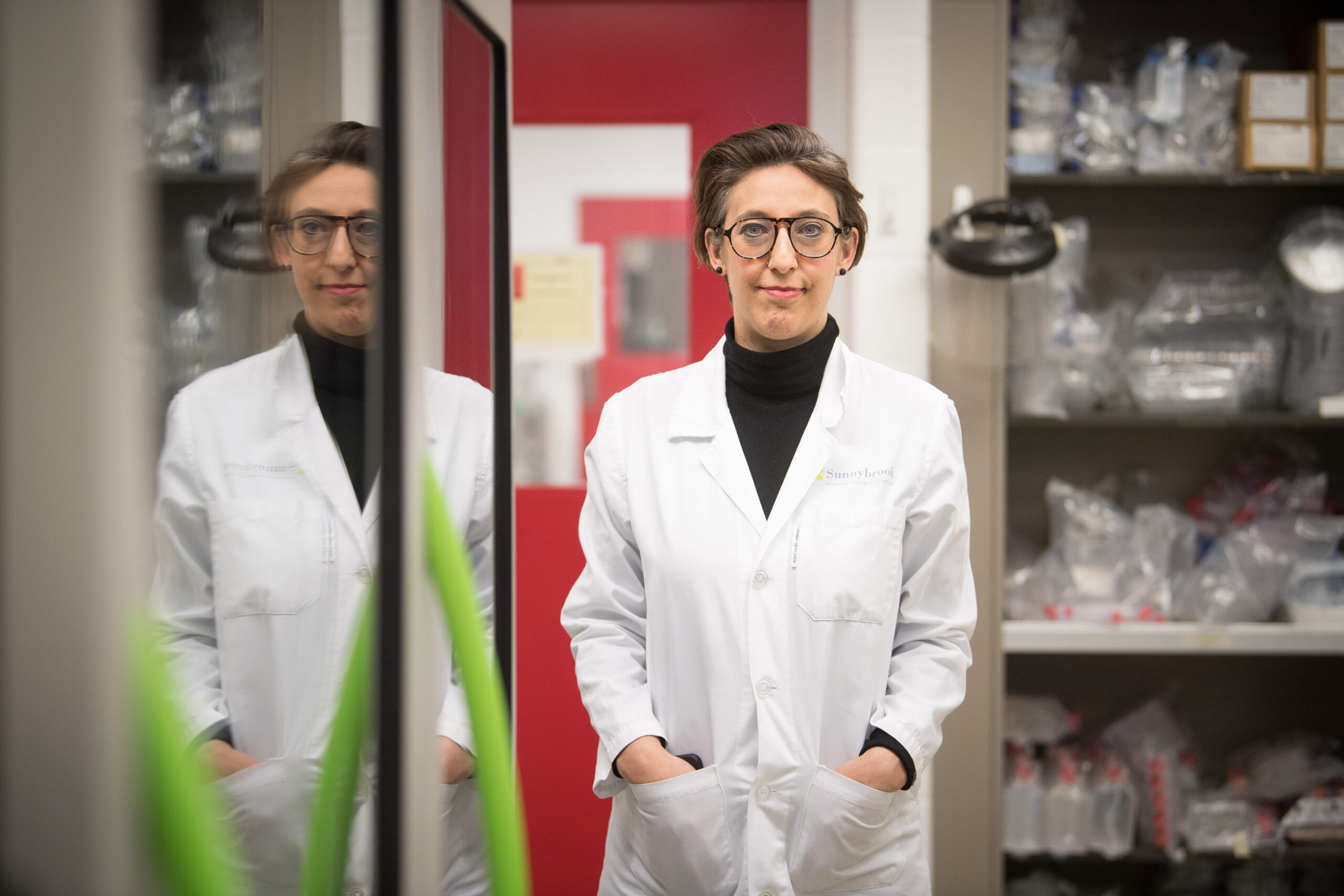Results of the 2023 Proof-of-Principle Grants Competition
The Emerging and Pandemic Infections Consortium (EPIC) is an integrated network for researchers, trainees and partners working to confront infectious disease challenges. We unite members across the University of Toronto and its hospital partners to accelerate cross-disciplinary work in the understanding and development of new countermeasures against pathogens. A key pillar of EPIC’s work is training the next generation of infectious disease research leaders that will help stop future pandemics and reduce the societal burdens of infectious disease.
EPIC Proof-of-Principle Grants support early stage and pilot level projects that show promise in developing novel understanding or innovations in the area of infectious disease and/or pandemic preparedness. This funding is intended to be agile and adaptive so that it can be deployed as rapid response funding when needed or provide seed funding within the EPIC community to support a strong pipeline of innovations in infectious disease research.
We are pleased to share the results of our inaugural Proof-of-Principle Grants competition that we launched in March 2023.
Total investment
Meet our 2023 Proof-of-Principle Grant recipients

Alex Ensminger
Department of Biochemistry, Temerty Faculty of Medicine
Project title: A newly identified pathway in Legionellales essential for virulence: from discovery to drugs

Samira Mubareka
Sunnybrook Research Institute
Project title: Highly pathogenic avian influenza in Canada: a multi-sectoral approach to rapid risk assessment

Michael Norris
Department of Biochemistry, Temerty Faculty of Medicine
Project title: Putting the brakes on the next pandemic: developing broadly active antivirals against emerging paramyxoviruses

Dana Philpott
Department of Immunology, Temerty Faculty of Medicine
Project title: Increasing mucosal vaccine efficacy by modulating resident gut microbiota

Matthieu Schapira
Department of Pharmacology and Toxicology, Temerty Faculty of Medicine
Project title: Proof-of-concept for pharmacologically targeting an ultra-conserved drug binding site on the SARS-CoV-2 helicase NSP13 for next generation COVID-19 antivirals
Project summaries
Alex Ensminger: A newly identified pathway in Legionellales essential for virulence: from discovery to drugs
The order Legionellales includes two important human pathogens: Legionella pneumophila (Legionnaires’ disease), responsible for over $400 million yearly in US hospitalization costs alone; and Coxiella burnetii (Q fever), a Risk Group 3 select agent with a lethal infectious dose of one. Both pathogens replicate intracellularly in their environmental reservoir hosts and in human lung macrophages–using arsenals of translocated effector proteins to rewire cellular trafficking and the immune response. Although molecularly fascinating, effectors represent unsuitable drug targets due to extensive genetic redundancy. We have identified an essential chromosomal repair pathway that is not only widespread across Legionellales but whose activity we have linked to virulence in both L. pneumophila and C. burnetii. Unlike effectors, this pathway depends on a single gene (XerL) whose disruption leads to a severe intracellular growth defect in Legionella. In this proposal, we will further characterize the contribution of this pathway to L. pneumophila and C. burnetii virulence. We will develop a high-throughput, in vivo assay suitable for identifying novel inhibitors of XerL. Together, this project lays the foundation for developing new antimicrobials against L. pneumophila, C. burnetii, and other Legionellales that depend on this pathway.
Samira Mubareka: Highly pathogenic avian influenza in Canada; a multi-sectoral approach to rapid risk assessment
Highly pathogenic avian influenza (HPAI) virus is currently the leading pandemic threat. Over the past year there has been an unprecedented level of activity among wild birds in Canada and across the globe. This has led to the most significant outbreak of HPAI among domestic poultry such as farmed and backyard chickens, ducks, and turkeys in North America, resulting in the depopulation of millions of birds, as well as high mortality among raptors and seabirds, which have seen massive die offs.
As HPAI continues to proliferate and reassort (gain genomic diversity) among wild and domestic birds and spillover into a growing list of mammals (mink, fox, seals, bear), there is a pressing need for immediate and coordinated collaborative action involving public, academic and private sectors to understand the drivers of viral transmission and identify and implement means by which to mitigate spread. It is also critical to understand the risks to human health and pandemic triggers. Often we recognized ‘the perfect storm’ for rare but highly impactful events after they happen- here we have an opportunity to act before there is major impact on human health.
The World Health Organization has developed the Tool for Influenza Risk Assessment (TIPRA), a framework for assessing risk of novel influenza viruses of animal origin, to estimate the likelihood and health impacts of viral spillover into humans. Here we propose to use an established infection model to compare the potential for transmission into mammals. This will be performed in close collaboration with the National Centre for Foreign Animal Disease (NFCAD), who have isolated and characterized Canadian A (H5N1) HPAI reassortants. This is one small aspect of a broader risk assessment that requires urgent and timely attention as we see a new rise in avian cases as the fall migration risks overlapping in seasonal human influenza activity.
Michael Norris: Putting the brakes on the next pandemic: developing broadly active antivirals against emerging paramyxoviruses
Future pandemics caused by highly transmissible and lethal respiratory viruses, particularly those in the paramyxovirus family, are a significant concern. Measles, which infects over 7 million people per year, parainfluenza, which causes croup, and the deadly Nipah virus, which has a mortality rate of 90%, are all examples of paramyxoviruses that are spread through the respiratory route. Currently, no therapies exist for any paramyxoviruses. A key component of the paramyxovirus machinery is the matrix protein. Thousands of matrix proteins attach to the inner surface of human cell membranes where they gather other viral proteins to build new copies of the virus and release them from infected cells. If we could target the matrix protein with an antiviral drug, viral assembly could be halted, thereby stopping virus spread. I determined the high-resolution molecular structures of several different paramyxovirus matrix proteins alone and in complex with a membrane lipid. This highly detailed view showed us how matrix proteins hijack the human cell membrane and revealed three vulnerable sites shared by many paramyxoviruses. Therefore, a drug targeting one of these sites could potentially block all or many paramyxoviruses. I identified 105 high-potential compounds using virtual drug screening, which involves using computer tools to evaluate millions of drugs for their potential to bind the matrix protein at each of the vulnerable sites. These compounds will now be evaluated for their ability to specifically block the assembly functions of the viral matrix protein and inhibit multiple live paramyxoviruses that are relevant for human health.
Dana Philpott: Increasing mucosal vaccine efficacy by modulating resident gut microbiota
This project focuses on improving oral vaccines by exploring the role of gut bacteria in our immune system. Traditional vaccines, administered through needles, might not provide the best protection against bacteria or viruses entering our bodies through the mouth or nose. Mucosal vaccines, delivered orally or nasally, are an alternative solution.
Recent research indicates that gut bacteria are crucial to vaccine effectiveness. This project aims to enhance oral vaccines by modifying gut bacteria to help strengthen our body’s immunity. The project’s two main objectives are: 1) Developing specialized gut bacteria that can boost our immune response, and 2) Testing if these modified bacteria can improve our body’s reaction to oral vaccines.
To this end, we will create a synthetic bacterial microbiome with increased cell wall production. Components of the bacterial cell wall are known to enhance immune responses. The next step will involve testing the ability of this enhanced microbiome to improve immune responses in animal models following oral immunization.
This research has the potential to revolutionize the field of oral vaccines, helping to protect more people from infectious diseases. Mucosal vaccines offer numerous advantages, such as being easier to administer. This could lead to higher vaccination rates, resulting in better protection for individuals and communities.
Additionally, this research could have broader implications for understanding the relationship between the gut microbiome and the immune system. Insights gained from this project could be applied to other areas of medicine, leading to a greater understanding of how our gut bacteria influence our overall well-being.
Matthieu Schapira: Proof-of-concept for pharmacologically targeting an ultra-conserved drug binding site on the SARS-CoV-2 helicase NSP13 for next generation COVID-19 antivirals
Paxlovid is a front-line antiviral in the treatment of COVID-19. While it is efficacious in most patients, reports of viral resistance are emerging, and are likely to increase as the virus mutates: next generation drugs are urgently needed before Paxlovid-resistant strains become prevalent. While Paxlovid targets a viral protein called a protease named Mpro, another important viral protein called a helicase named NSP13 is found to be much less mutated in samples from COVID-19 patients. This strongly suggests that it would be much more difficult for the virus to escape drugs targeting this protein. However, such molecules have not yet been developed and proof-of-concept remains to be established. We are working with over twenty leading artificial intelligence (AI) and computational drug discovery teams around the world to design drug-like molecules targeting NSP13 and are starting to test experimentally 2000 predicted compounds. We expect that a few dozen molecules will be confirmed experimentally, but these preliminary “hits” will not engage NSP13 potently enough to have antiviral effect. We propose to test 200 to 300 chemical analogs of the most promising hits to find more potent molecules and demonstrate that they block SARS-CoV-2 viral replication. Our results will establish proof-of-concept that pharmacologically targeting NSP13 is a promising strategy for next-generation COVID-19 drugs.




